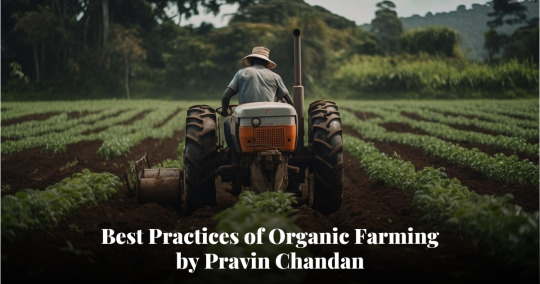Text
Pravin Chandan’s Best Practices of Organic Farming Done in India to Maximizing Yield
Organic farming is gaining immense popularity in India as more and more people are becoming aware of the side effects of chemical fertilizers. Consequently, many farmers are adopting organic farming practices.
Organic farming focuses on growing crops naturally without using synthetic substances or chemical fertilizers. The process uses biological materials and emphasizes soil fertility and ecological balance.
In recent years, the demand for organic farm products has grown tremendously. Farmers are producing organic foods globally to meet the vast market demands. However, if one is farming continuously in the same soil, the soil’s natural nutrients tend to deplete. Since synthetic-based fertilizers and pesticides aren’t an option to replenish the soil’s nutrients, farmers must adopt different practices to maximize their yield.

Organic Farming Practices to Increase Yield - Suggestions by Pravin J Chandan
Organic farming practices vary based on crops, climates, and regions. However, some common practices that can help increase the yield are discussed below.
Crop Rotation
Crop rotation is a promising technique to maintain soil fertility, reduce the accumulation of pests and diseases, and prevent soil erosion. Growing legumes in rotations helps to fix nitrogen in the soil.
Addition of Biofertilisers
Biofertilizers like azotobacter, rhizobium, and phosphate-solubilising bacteria improve soil fertility and provide nutrients to plants. They are eco-friendly alternatives to chemical fertilizers.
Mulching
In the process of mulching, organic materials like leaves, straw, or crop residues are used to cover the soil. It helps to moderate soil temperature, conserve soil moisture, reduce soil erosion, and suppress weed growth. Mulches are also a great habitat for beneficial soil organisms.
Composting
Composting is a popular practice employed by Indian farmers. It recycles organic matter and enhances the soil’s nutrients. Compost promotes healthy plant growth by improving soil structure, microbial activity, and water retention.
Green Manure
Green manure crops enrich the soil with organic matter, improve soil health, and suppress weeds. Some of these crops include cowpea, dhaincha, and sunn hemp. They are often sowed into the soil before planting cash crops.
Water Management
In regions prone to water-related challenges, efficient water management techniques help optimize water use efficiency and sustain crop production. These techniques include rainwater harvesting, drip irrigation, and moisture conservation.
Soil Conservation Measures
Soil conservation measures avoid soil erosion, boost moisture retention, and maintain soil structure, especially on sloping lands. Farmers can conserve soil with terracing, bundling, and contour plowing.
Summary
Many people around the globe have learned about the advantages of organic farming. Consequently, the demand for organic produce has increased. Farmers need to implement the organic farming practices shared above from Pravin Chandan profile to increase their yield and contribute to food security. These practices don’t impact human health and ecosystems negatively.
Source Link: https://pravinchandan.com/blog/post/pravin-chandans-best-practices-of-organic-farming-done-in-india-to-maximizing-yield
0 notes
Text
Exploring the Benefits of Organic Farming for Health and Environment
The fruit and vegetable section at a supermarket has some organic products. They are priced higher than the non-organic produce, but they look similar. What is the cause of this difference? What is organic farming, and how it benefits human health and the environment?
Pravin Chandan, a well-known mentor in the Direct Selling Industry, shares insights about organic farming in India to help you learn more about it.

What is Organic Farming?
Organic farming is an agricultural process that relies on animal or plant waste-based biological fertilisers and pest control. It evolved to combat the environmental sufferings arising from the use of synthetic fertilisers and chemical pesticides. It is a new farming or agricultural system that repairs, maintains, and improves the ecological balance.
Health and Environmental Benefits of Organic Farming
Organic farming aims to improve the health of humans and the environment. It focuses on managing the ecosystem instead of depleting it. The process is characterised by a natural approach that avoids using synthetic chemicals and offers produce that is more nutritional, tasty, and healthy.
Reduced chemical usage
Organic farming reduces the use of synthetic chemicals significantly. Farmers use natural methods of pest and weed control, like adding beneficial insects, companion planting, and crop rotation. This lesser use of chemicals lowers the risk of chemical residues in your food and prevents contamination of the soil, air, and water.
Maintains a healthy soil
Conventional farming methods use pesticides and chemicals which contaminate the soil. If the ground isn’t healthy to begin with, you cannot get healthy produce. Organic farming emphasises good soil health. It uses natural and organic materials to enrich the soil. This approach results in better water retention, enhanced soil structure, and increased microbial activity.
Provides a nutrient-rich produce
Farmers get better crop yields, as organic farming methods don’t contaminate the soil and maintain its health. These yields are richer in vital nutrients such as vitamins, minerals, and antioxidants. Consuming such nutrient-rich fruits, vegetables, and grains helps in maintaining overall health and boosting the body’s immune system.
Better taste and flavour
Many supporters of organic farming certify that organic produce offers a superior taste and flavour. Organic farming emphasises soil health and allows crops to ripen naturally, thus yielding fruits and vegetables with enhanced texture, taste, and aroma.
Summary
The increasing population and the growing demand for food in the future, along with the need to conserve natural resources, have led to the growth of organic farming in India. Organic farming is one of the practices that promote environmental and human health. By embracing natural farming methods, you prioritise the environment’s health, the economy, the future, and your well-being.
Source URL: https://pravinchandan.com/blog/post/The-Benefits-of-Organic-Farming-A-Guide-by-Pravin-Chandan2
0 notes
Text
The Future of Direct Selling in India: Trends, Challenges, and Opportunities | Pravin Chandan
The Future of Direct Selling in India: Insights
The future of direct selling looks bright, with new technologies and platforms providing opportunities for growth and innovation. Companies that are able to adapt to the changing marketplace and stay ahead of these trends are likely to be the ones that thrive in the coming years.
The Future of Direct Selling in India: Key Predictions and Insights
Predictions for the future of direct selling in India
Emerging trends and innovations in the industry
Implications for marketers and businesses operating in the Indian market
The future of direct selling is expected to be shaped by several key trends, including the use of artificial intelligence and machine learning to personalize the customer experience, the growth of e-commerce and social media platforms, and the increasing focus on sustainability and social responsibility.
Other trends that are likely to shape the future of direct selling include the rise of the gig economy and the increasing importance of trust and transparency in the industry.
Companies that are able to stay ahead of these trends and adapt to the changing marketplace are likely to be the ones that succeed in the future.

The Hindu Business Line Highlight about Direct Selling Industry:
The direct selling industry in India is expected to reach a value of Rs 18,673 crore by 2025.
Factors contributing to the industry's growth include rising consumer awareness and demand for high-quality products, increasing penetration of e-commerce and social media, and a growing entrepreneurial spirit among the country's youth.
The industry has seen an increase in demand for health and wellness products, as consumers prioritize their well-being during the pandemic.
The report emphasizes the significant growth potential of the direct selling industry in India and the importance of companies adopting innovative technologies and meeting changing consumer needs to stay ahead of the curve.
Direct Selling in India: An Overview Report by Invest India
Direct selling has been present in India for more than five decades and has evolved over the years to become a significant contributor to the country's economy, providing employment opportunities and enabling entrepreneurship.
The industry is diverse and includes both Indian and international companies operating in various sectors, such as health and wellness, beauty, and household products.
The direct selling industry in India faces challenges, including regulatory and legal issues, lack of consumer awareness and trust, and fraudulent activities.
The government has taken steps to address these challenges and support the industry's growth, such as setting up a dedicated ministry and developing a code of ethics for direct selling companies.
The report emphasizes the industry's potential to contribute to the country's economic growth and development, while also highlighting the need for stakeholders to work together to address challenges and build a sustainable and thriving industry.
The FICCI report provides insights:
Into the opportunities and challenges facing the direct selling industry in India, and emphasizes the importance of addressing regulatory and consumer trust issues to unlock the industry's full potential.
Direct selling is an important contributor to the Indian economy, providing employment opportunities and empowering individuals to become entrepreneurs.
The industry has experienced steady growth over the years, but faces several challenges such as a lack of regulatory clarity and consumer trust.
The report emphasizes the need for a clear and consistent regulatory framework to promote transparency and protect consumers.
Direct selling companies also need to focus on building trust with consumers through ethical business practices and quality products.
The report highlights the potential for the industry to grow and become an even more significant contributor to the Indian economy if these challenges are addressed and opportunities are leveraged effectively.
The report also provides recommendations for the government, industry stakeholders, and consumers to promote the growth and sustainability of the direct selling industry in India.
Source Link: https://pravinchandan.com/blog/post/the-future-of-direct-selling-in-india
0 notes
Text
Organic Farming Insights in India: Shared by Pravin Chandan
With the population on a consistent rise worldwide, agricultural systems need to accommodate the growing food demand. As a result, they have implemented several unsustainable methods to produce higher yields. These methods use chemicals excessively, leading to multiple global issues like soil degradation, soil erosion, water pollution, loss of biodiversity, and climate change.
Organic farming in India is an incredible solution to help achieve food security goals through sustainable agriculture practices.
What is Organic Farming?
Organic farming refers to natural, eco-friendly, and sustainable practices of farming. Its produce is clean and healthy for the consumers and economically advantageous for the farming communities. The practice focuses on reducing or eliminating external inputs like artificial fertilizers, pesticides, additives, etc.
Growth of Organic Farming in India
India ranks number one for the total number of organic farmers as per 2021 data and sixth for the World’s Organic Agricultural land. (Source: FIBL & IFOAM Year Book, 2023).
The world’s first state to become completely organic was Sikkim. States like Uttarakhand and Tripura follow with similar targets.
The use of chemicals in North East India is much less than in the rest of the country.
The total area registered for organic farming under the National Programme for Organic Production is 10.17 million hectares as of 31st March 2023.
Madhya Pradesh has the largest area covered under organic certification.
In 2022-2023, India produced approximately 2.9 million metric tons of certified organic products. These included different varieties of food products like sugarcane, millet, cereals, oil seeds, pulses, cotton, tea, coffee, spices, fruits, vegetables, dry fruits, aromatic and medicinal plants, fibre, processed foods, etc.
Methods of Organic Farming in India - A Brief Overview by Pravin Chandan
Different techniques of organic farming are practised in India. Here’s a brief overview of each of them.
Soil Management
Soil management is the first organic farming technique. It focuses on using bacteria available in animal waste to increase the soil’s fertility and productivity.
Weed Management
Weed removal is the next organic farming method. One option is to move or cut the weed. The second option is mulching. Farmers use plant residue or a plastic film on the soil’s surface to restrict the weed’s growth.
Crop Diversity
One of India’s most famous organic farming methods is crop diversity. It focuses on cultivating different crops together to cater to the growing crop demand.
Natural Management of Organisms
To save the soil and crops, it is essential to control the growth of organisms. This organic farming method uses natural or fewer chemicals, pesticides, and herbicides to protect soil and crops.
Biological Pest Control
This method uses living organisms with or without chemicals to control pests.
Final Thoughts
Many Indian farmers use the above methods of organic farming in India. The practice is affordable as there is no expense of pesticides, fertilizers, or HYV seeds for crop plantation. Farmers can earn a good return on investment using local and inexpensive inputs.

Source: https://pravinchandan.com/blog/post/Organic-Farming-Insights-in-India-Shared-by-Pravin-Chandan
1 note
·
View note